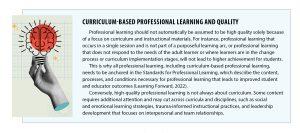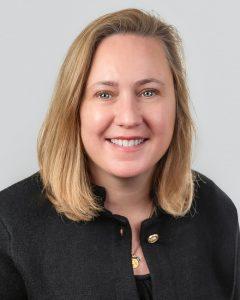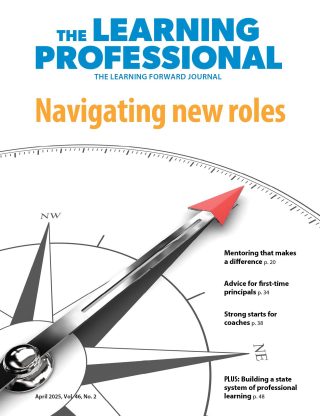FOCUS
Curriculum-based professional learning benefits students and teachers
By Elizabeth Foster
October 2024
Corinne Zaccaria, a 6th-grade math teacher in the School District of Philadelphia in Pennsylvania, knew that using a high-quality curriculum in her classroom was important. But when her school began using Illustrative Mathematics, a curriculum that is highly rated by independent reviewers, she found it daunting.
“At the beginning of the year, implementation was scary. I didn’t feel fully prepared to implement it,” she said. The curriculum requires students to build their understanding of math concepts over several lessons, and Zaccaria found that “it was hard at the beginning of the year trying to let (my students) work through the productive struggle.”
But things began to change for Zaccaria — and more importantly, for her students — after she began participating in the Curriculum-Based Professional Learning Network facilitated by Learning Forward. Through the network, teachers, instructional coaches, and leaders dove into Illustrative Mathematics, engaging in it the same way their students would, practicing instructional strategies, and identifying challenges and finding solutions to them.
After participating in the network for one school year, Zaccaria said that being part of the network has helped her grow as a teacher and improve her instruction, citing the value of “getting to hear strategies from teachers from other schools, other grade levels, as well as from coaches and the administration.”
Working through the curriculum together with colleagues to learn about various instructional strategies and resources in the curriculum “has made students have a deeper understanding of the content,” she said. “I am seeing the growth that my students are having because of the curriculum.”
Zaccaria’s students are not alone. In just one year, schools that participated in the Curriculum-Based Professional Learning Network saw strong growth in teacher practice and student outcomes. There was an increase in the integrity of curriculum implementation, which led to increased student engagement and improved student achievement. Ninety-six percent of network participants reported that their understanding of curriculum-based professional learning had increased, and 93% reported that they now understand what data is needed to determine improvements in curriculum implementation.
''In just one year, schools that participated in the Curriculum-Based Professional Learning Network saw strong growth in teacher practice and student outcomes.'' #CBPL Share on XThat learning from participating in the network means that more teachers are understanding the value of and strategies for high-quality curriculum so that students can access content that makes a difference for them. Alexander Riccardo, a 7th-grade math teacher in Philadelphia who also participates in the network, said, “I have found that the more I use (the curriculum) with integrity, the more the students had a better use of mathematical language … (and) the better the results in their formative assessments afterward.”
Why educators need curriculum-based learning
One reason states and districts adopt high-quality, standards-aligned curricula is so teachers don’t spend time creating or finding their own materials, allowing them to focus instead on their classroom teaching, analyzing student data, and planning how to tailor content and instruction to meet individual student needs (Instruction Partners, 2017). Using a high-quality curriculum also provides greater coherence and alignment across individual classrooms and grade levels, making it an important factor in achieving equity (Learning Forward, 2018).
But high-quality curricula, on their own, are not enough. Even when a school adopts a high-quality curriculum, many teachers don’t use it or implement it incompletely or without a deep understanding of the concepts and structures. Even teachers like Zaccaria, who understand the value of the curriculum, can find it challenging to implement.
Today’s high-quality curricula are focused on inquiry and making meaning from real-world phenomena and experiences. Many teachers didn’t learn in this way when they were students or when they were teachers in training, so they need and deserve opportunities to dive into the curriculum and become experts at applying it.
The implementation of this kind of professional learning is a complex and challenging undertaking (Chu et al., 2022). It requires putting into practice all the components we know make professional learning high quality, which are outlined in the Standards for Professional Learning (Learning Forward, 2022). Curriculum-based professional learning should be job-embedded, relevant and responsive to classrooms and instructional practices, and sustained, with multifaceted and appropriate learning designs.
Learning Forward’s Curriculum-Based Professional Learning Network
Learning Forward, with grant funding from the Carnegie Corporation of New York, developed the Curriculum-Based Professional Learning Network to help educators engage in this kind of high-quality curriculum-focused learning and implement curricula with integrity so that student learning improves.
We launched the network in fall 2023 with three large districts that were in the early stages of implementing Illustrative Mathematics: the School District of Philadelphia in Pennsylvania, Metro Nashville Public Schools in Tennessee, and Montgomery County Public Schools in Maryland.
District teams are composed of math teachers, coaches, and school and district leaders. Learning Forward leads regular, goal-focused professional learning with each team, drawing on research about best practices and on the curriculum and the instructional materials themselves.
For instance, experiencing the curriculum the way students will experience it has been shown to be an effective professional learning strategy (Short & Hirsh, 2022). Therefore, every in-person professional learning session includes an extended active learning session in which the educators “put on their student hats” (Klein & Riordan, 2011) to do the math lessons using the guiding principles of problem-based teaching and learning articulated in the curricular materials.
We work with team members to engage with and understand the materials while also being responsive to the needs of each educator and their school and district contexts.
All of this is built on a strong research base about professional learning and a decade of experience about how to ensure participants are supported to learn and achieve their goals, individually and collectively. The cadence and progression of learning are grounded in well-established theories of change management and adult learning, and each learning session is carefully designed to build on the previous one, taking into account the data and feedback from participants, information from coaching sessions, and progress toward the district and network goals.
To accomplish this, we look to the Standards for Professional Learning, which emphasize how professional learning is a recursive process that builds over time and is responsive and adaptive to what came before.
Teachers at the center
Teacher voice and perspectives are central to the network. Teachers are the most direct change agents because they are the ones who implement the curriculum with students. They are also the people who most commonly test the change ideas identified by the teams, collect data, and report back to the school teams about their findings to determine next steps.
To implement the curriculum successfully, teachers need to be at the center of developing the teams’ understanding of classroom-level challenges, collaboratively determining potential strategies for improvement, planning how to implement a specific change idea, and collecting data to assess whether their new strategy results in improved outcomes.
For example, many teachers find it difficult to get to all of the components of the curriculum because of time constraints, scheduling conflicts, and competing priorities. Illustrative Mathematics assumes that class periods are 60 minutes long, but in many schools, classes are only 45 minutes. In addition, class periods are sometimes interrupted by fire drills, assemblies, and test preparation and administration, which can set teachers and students back in the intended pacing.
Teachers are best positioned to identify these challenges and ways to address them. This is an important shift from more traditional top-down approaches. As Patti Swift, a secondary math coach for Montgomery County Public Schools, said, “One of the biggest shifts is that we are having the teachers set goals for how they want to change things in their classrooms.” This approach builds teachers’ agency, buy-in, and ultimately their capacity and willingness to implement the curriculum.
Focusing on change ideas
Rather than take on the entire curriculum and all the challenges at once, we supported teams to choose a particular aspect of the curriculum they wanted to improve. Schools continued to implement the whole curriculum, but they focused their improvement work on a specific strategy or curriculum component. The change ideas varied by team because each team faced different pressing challenges. Change ideas included the following:
A team that found it frequently ran out of time for the lesson synthesis focused on using collaborative planning time to adjust its use and pacing of instructional time.
A team with the long-term goal of increasing students’ understanding of and facility with math concepts focused on improving the use of math language routines, a way the curriculum structures student dialogue to promote student engagement and productive struggle.
A team that found the amount of narrative language in the curriculum challenging for its English learner students tested a strategy of having students annotate the lessons.
After identifying their goals and change ideas, teams conducted the first in a series of plan-do-study-act (PDSA) cycles, a structure for studying discrete changes and modifying them based on lessons learned. These cycles, which are grounded in improvement science (Bryk et al., 2015), foster ongoing inquiry and reflection.
Learning Forward then facilitated monthly virtual coaching sessions to help teams discuss their change ideas for improving curriculum implementation, reflect on real-time process data about changes in instruction and student learning, and determine whether to adopt the change idea strategy, adapt it, or abandon it in favor of a different strategy tied to curriculum implementation.
We also hosted monthly virtual professional learning sessions where all teams could learn together, problem-solve, and share tools and strategies as well as two in-person cross-network meetings. Teams shared data, findings, and reflections through the network for the benefit of all.

Improvements in student learning
To determine whether the implementation of curriculum was improving and whether student achievement was rising, we tracked progress on several levels. The districts were at different stages in their implementation of the Illustrative Mathematics curriculum, so progress and growth looked different across the three school systems. But each made strides in their own way in year one, and we anticipate further improvements in year two, which is underway now.
Montgomery County: Students in network schools improved their scores on district and school math assessments and are outperforming others in the district on common formative assessments. For example, at Neelsville Middle School, about 75% of students showed growth from fall to winter on the district math performance assessment.
Sixth graders whose teachers participated in the network outperformed the county average on the Illustrative Math cool-down by almost 17% in December, only a few months after the network began.
Changes in teachers’ instructional practices over the same time period suggest that the work being done in the network is leading to these improvements. For example:
At Neelsville Middle School, teachers reported completing the lesson synthesis — a core component of the curriculum, but one that many teachers find challenging to get to — in over 60% of their classes after starting at close to zero at the beginning of the year.
At Gaithersburg Middle School, teachers increased their use of math language routines as part of their lesson instruction after they spent planning and professional learning time on better understanding how to use these routines in each unit and lesson. Students in the classrooms where teachers are increasingly using math language routines are talking more about math concepts, as shown in the teacher tallies about whether students are talking and what they are talking about.
At Shady Grove Middle School, teachers are planning and implementing the math language routines 70% of the time. As teachers changed their instructional routines, student-to-student discourse increased.
Metro Nashville: English learner students are showing progress after 6th- and 8th-grade teachers implemented a strategy focusing on teaching students to annotate their work and thereby increase their math vocabulary and understanding. For example, at Goodlettsville Middle School, students of participating teachers scored above district averages on the WIDA Access assessment, an assessment used for English learner students.
The number of English learner students meeting their growth standard was 5.6% higher than the district rate for 6th graders and 2.4% higher than the district rate for 8th graders. In contrast, among 7th graders, whose teachers did not implement the annotation strategy, the percentage of English learner students meeting their growth goal was 9.4% lower than the district rate.
Samantha Spencer, a 6th-grade teacher, explained, “We have a very high English language learner and special education population. And the students just literally could not understand the text … so we broke down the language and made it so that our students could work.”
She believes there was a direct connection between the implementation strategy and student results. “Because of the annotation and the focus on making sure they understood the language in the book itself, they were able to make growth,” she said.
Philadelphia: Harding Middle School teachers focused on improving student engagement in the warm-up, the component of the Illustrative Math curriculum that activates prior knowledge and foreshadows the day’s activities. According to tally sheets that teachers use to track students’ completion and quality of lesson warm-ups, students are engaging more with the curriculum.
Teacher Alexander Riccardo reported that not only did students “get to the tools and materials right away, but also were getting more efficient with content-related responses, reflecting an increased engagement and understanding.” He also observed a higher percentage of students mastering the cool-downs, meaning that they were grasping and able to articulate the point of the lesson.
Improvements in teacher practice
Looking across the network, data suggest that participating educators are improving their knowledge, skills, and practices, which are likely leading to the improvements they see with their students. For example:
Participating educators consistently report on surveys that their participation is relevant to their daily work, the network learning is providing them with strategies to support traditionally underserved students, and they appreciate learning from and collaborating with colleagues from their own and other schools and districts.
Learning Forward’s monthly coaching calls with the teams reveal that both collaborative planning time and coaching provided by the instructional coaches are increasingly focused on improving curriculum implementation.
Nearly all participants said that over the year of engaging with the network, their understanding of curriculum-based professional learning improved. (One teacher responded “not sure” while the other 27 responded yes.)
In addition, participants are showing more understanding that professional learning and continuous improvement go hand in hand. Tyrunya Goodwin, a district lead coach for Metro Nashville Public Schools, said that the network has helped shift her team’s mindset to: What do we need to adopt or what do we need to adapt? What do we need to abandon? That kind of mindset is important for building teachers’ buy-in, self-efficacy, and accurate execution of the curriculum elements.
We believe part of the reason educators are making this shift is that they are engaging with high-quality resources themselves — not just the Illustrative Mathematics curriculum, but also the Standards for Professional Learning and related resources, through which they develop a deeper understanding of what high-quality professional learning is, and the book Transforming Teaching Through Curriculum-Based Professional Learning: The Elements (Short & Hirsh, 2022) to enhance their understanding of what curriculum-based professional learning entails and how it differs from other professional learning they may have experienced in the past.
Looking ahead
As the Curriculum-Based Professional Learning Network moves into a second year, Learning Forward is reflecting on the data, considering feedback from participants, and making plans to improve the network — similar processes to what we encourage the participants to do in their work.
We have a lot of lessons and successes to build on from year one, especially among the teams of educators who have invested time and energy over the first year of their engagement with the network.
We have already seen the power of small changes focused on how educators use high-quality curriculum well. When educators are the ones driving the changes, implementing the curriculum with integrity doesn’t require additional time. Rather, with these small improvements, educators are better using time.
Carla Richards, a numeracy coach in Metro Nashville Public Schools, summed up the past year of learning and her team’s hopes for the coming year and beyond: “It has been a process … . We picked up the curriculum and we started working and there was growth, growth among the teachers and growth among the students … . We grew in certain ways, but there are so many opportunities for more growth.”
Download pdf here.
References
Bryk, A.S., Gomez, L.M., Grunow, A., & LeMahieu, P.G. (2015). Learning to improve: How America’s schools can get better at getting better. Harvard Education Press.
Chu, E., McCarty, G., Gurny, M., & Madhani, M. (2022). Curriculum-based professional learning: The state of the field. Center for Public Research and Leadership, Columbia University.
Instruction Partners. (2017). What does it take to implement a strong curriculum effectively? Part 1: What do we know about the experience of schools implementing rigorous curricula? Author.
Klein, E.J. & Riordan, M. (2011). Wearing the “student hat”: Experiential professional development in Expeditionary Learning schools. Journal of Experiential Education, 34(1), 35-54.
Learning Forward. (2018). High-quality curricula and team-based professional learning: A perfect partnership for equity. Author.
Learning Forward. (2022). Standards for Professional Learning. Author.
Short, J. & Hirsh, S. (2022). Transforming teaching through curriculum-based professional learning: The elements. Corwin.

Elizabeth Foster is the senior vice president of research and strategy at Learning Forward. She leads the organization’s research efforts for partnerships, programs, and fundraising. Elizabeth co-wrote the Standards for Professional Learning (2022) with Tracy Crow and now facilitates learning sessions about the standards and develops resources that support their use and implementation.
Recent Issues
LEARNING DESIGNS
February 2025
How we learn influences what we learn. This issue shares essential...
BUILDING BRIDGES
December 2024
Students benefit when educators bridge the continuum of professional...
CURRICULUM-BASED PROFESSIONAL LEARNING
October 2024
High-quality curriculum requires skilled educators to put it into...
LEARNING TO PIVOT
August 2024
Sometimes new information and situations call for major change. This issue...












